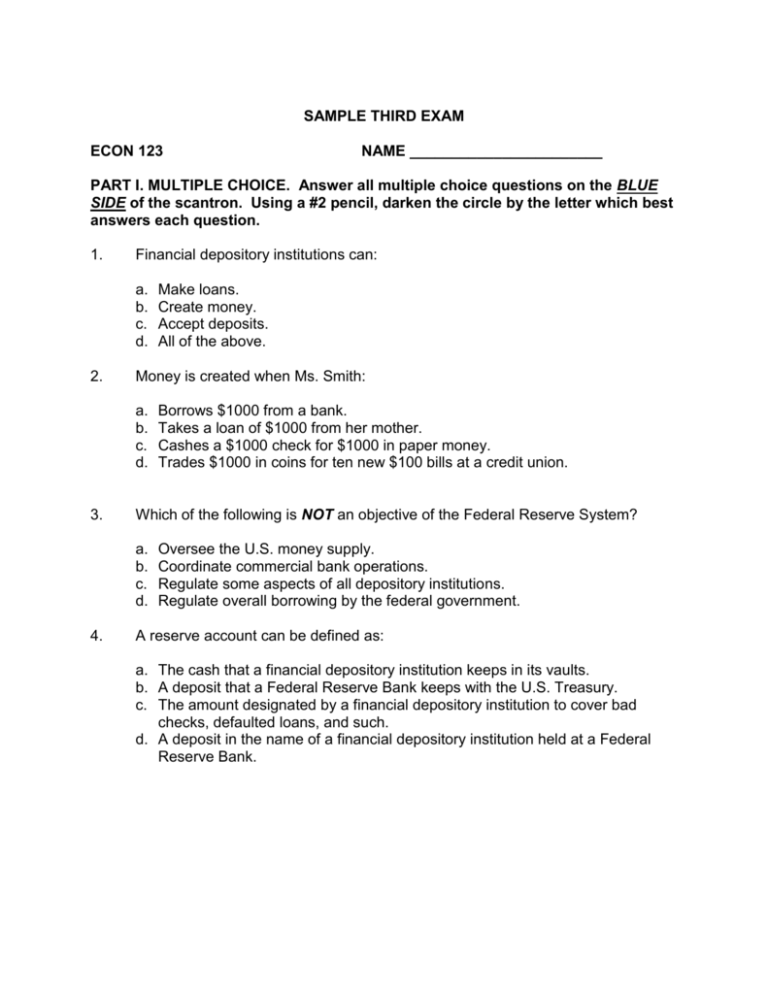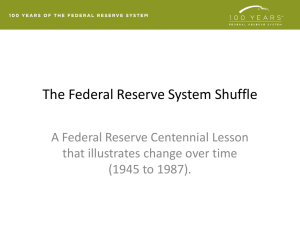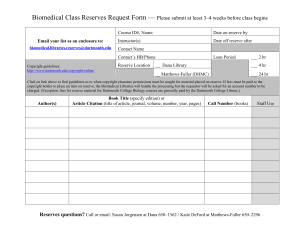sample third exam - Shepherd Webpages
advertisement

SAMPLE THIRD EXAM ECON 123 NAME _______________________ PART I. MULTIPLE CHOICE. Answer all multiple choice questions on the BLUE SIDE of the scantron. Using a #2 pencil, darken the circle by the letter which best answers each question. 1. Financial depository institutions can: a. b. c. d. 2. Money is created when Ms. Smith: a. b. c. d. 3. Borrows $1000 from a bank. Takes a loan of $1000 from her mother. Cashes a $1000 check for $1000 in paper money. Trades $1000 in coins for ten new $100 bills at a credit union. Which of the following is NOT an objective of the Federal Reserve System? a. b. c. d. 4. Make loans. Create money. Accept deposits. All of the above. Oversee the U.S. money supply. Coordinate commercial bank operations. Regulate some aspects of all depository institutions. Regulate overall borrowing by the federal government. A reserve account can be defined as: a. The cash that a financial depository institution keeps in its vaults. b. A deposit that a Federal Reserve Bank keeps with the U.S. Treasury. c. The amount designated by a financial depository institution to cover bad checks, defaulted loans, and such. d. A deposit in the name of a financial depository institution held at a Federal Reserve Bank. 2 5. A financial depository institution’s actual reserves are equal to the: a. b. c. d. 6. Amount of deposits in the institutions. Required reserve ratio times the institution’s deposits. Required reserve ratio times the institution’s reserve account. Amount the institution has in its reserve account plus its vault cash. Excess reserves: a. Equal actual reserves minus required reserves. b. Determine the value of new loans that can be made by a depository institution. c. Are actual reserves over and above the amount a depository institution is required to hold as actual reserves. d. All of the above. 7. If the required reserve ratio is 25% (.25), the money multiplier is: a. b. c. d. 1. 4. 25. 75%. 8. If the required reserve ratio were decreased from 20 percent to 15 percent, the money multiplier would: a. Increase. b. Decrease. c. Not be affected. d. Change in no predictable way. 3 9. The price paid to borrow money, which is expressed as a percentage of the amount borrowed, is the: a. b. c. d. Fund rate. Interest rate. Required reserve ratio. Balance requirement. 10. Financial, legal, technological, and other factors that prevent firms from coming into a market are: a. b. c. d. Barriers to entry. Illegal. Not found in the United States. Found in perfectly (purely) competitive markets. 11. A perfectly (purely) competitive seller’s demand curve for its product is perfectly horizontal because: a. b. c. d. There are other sellers in the firm’s market. The firm has no control over the price it receives for its product. The market is difficult to enter and exit. The firm produces a different product from that of its competitors. 4 USE THE GRAPH OF A TYPICAL FIRM IN A PERFECTLY (PURELY) COMPETITIVE MARKET TO HELP YOU ANSWER QUESTIONS 12 AND 13. $ ATC $10 D=P $7 25 12. If the firm produces 25 units of output it: a. b. c. d. 13. Is earning an economic profit greater than zero. Is earning an economic profit less than zero. Is earning an economic profit equal to zero. Is earning a normal profit. If all firms are like the typical firm above, then over the long-run: a. b. c. d. 14. Output (q) Some firms will leave the market. New firms will enter the market. The number of firms in the market will remain the same. Firms will enter and exit the market. Which of the following is not a characteristic of a pure monopoly? a. b. c. d. Economic profits always move toward zero in the long-run. Barriers prevent the entry of new firms into the market. The product sold has no close substitutes. The industry has only one seller. 5 ANSWER QUESTIONS 15, 16, AND 17 AND BY REFERRING TO THE DIAGRAMS OF THE MARKET FOR LOANS BELOW. Interest Rate (i) S Interest Rate (i) A S A i1 i1 D’ D’ D D L1 PANEL A Interest Rate (i) Loans (L) S L1 Loans (L) PANEL B Interest Rate (i) A i1 D L1 PANEL C S A S’ i1 S’ Loans (L) D L1 Loans (L) PANEL D 15. The effect of an increase in excess reserves on interest rates and the amount of loans made is shown by the movement from: a. D to D’ in Panel A. b. D to D’ in Panel B. c. S to S’ in Panel C. d. S to S’ in Panel D. 16. The effect of an increase in the required reserve ratio on interest rates and the amount of loans made is shown by the movement from: a. D to D’ in Panel A. b. D to D’ in Panel B. c. S to S’ in Panel C. d. S to S’ in Panel D. 17. The effect of a decrease in the amount of borrowing by households on interest rates and the amount of loans made is shown by the movement from: a. D to D’ in Panel A. b. D to D’ in Panel B. c. S to S’ in Panel C. d. S to S’ in Panel D. 6 18. If the economy is in a recession, the Federal Reserve would probably: a. b. c. d. Increase the banking system’s excess reserves. Decrease the banking system’s excess reserves. Increase the banking system’s required reserves. All of the above. 19. The correct Federal Reserve policy to counteract demand-pull inflation would be to: a. Buy securities in the open market, raise the required reserve ratio, raise the discount rate. b. Sell securities in the open market, raise the required reserve ratio, raise the discount rate. c. Buy securities in the open market, lower the required reserve ratio, lower the discount rate. d. Sell securities in the open market, lower the required reserve ratio, lower the discount rate. 20. The most commonly used tool of monetary policy is: a. b. c. d. 21. A sole proprietorship is a: a. b. c. d. 22. Legal entity with limited liability. Single-owner business with limited liability. Single-owner business with unlimited liability. Multiple-owner business with unlimited liability. Difficulty in raising large amounts of funds is a problem mainly for: a. b. c. d. 23. Open market operations. The discount rate. The required reserve ratio. Borrowing by the Treasury Department. Corporations. Partnerships and corporations. Sole proprietorships and corporations. Sole proprietorships and partnerships. Most businesses in the United States are legally organized as: a. b. c. d. Corporations. Partnerships. Sole proprietorships. Holding companies. 7 24. In economics, it is assumed that the basic goal of a firm is to: a. b. c. d. 25. Maximize its sales revenues. Drive its rivals out of business. Maximize profit or minimize loss. Maximize the recognition of the company among its buyers. Which level (or levels) of output appear in the range of economies of scale? $ ATC 200 a. b. c. d. 26. 550 Output 200. 400. 550. All of the above. Economies of scale in production can result from: a. b. c. d. 27. 400 High fixed costs of production. Increased specialization by the labor force. The use of highly bureaucratic rules and procedures. Both a and b. A nation is said to have a comparative advantage when it has a: a. b. c. d. larger demand for a product than does another nation. larger inventory of a product to sell than does another nation. lower opportunity cost of producing a product than does another nation. monopoly over a product and, through that, complete control over its price. 8 28. You would expect free, or unrestricted, international trade to: a. b. c. d. 29. limit the sizes of markets in which goods are bought and sold. reduce competition in markets where goods are traded internationally. reduce the possibilities for specialization in the use of factors of production. reduce the prices of traded goods below what they would be with trade restrictions. Which of the following is NOT an argument for free trade? a. b. c. d. It leads to greater efficiency. It leads to greater competition. It leads to more goods available and lower prices. It leads to greater diversification of industries in a country. 9 PART II. PROBLEMS AND ANALYSIS. Answer these questions on the exam sheet. 1. Suppose Bank A’s Balance Sheet reveals the following information: Actual Reserves Checkable deposits $ 10,000 100,000 The required reserve ratio is 5% (.05). a. What is the maximum amount of new loans Bank A can make? SHOW ANY CALCULATIONS AND PROVIDE A BRIEF EXPLANATION. (5 points) b. Calculate the money multiplier. SHOW WORK. (2 points) c. Assume Bank A lends out the maximum that it can and the other banks in the banking system do the same. What is the maximum amount of loans (and therefore new money) the banking SYSTEM can make? SHOW WORK. (3 points) 10 2. Suppose you own The Tattered Toad T-Shirt Factory. The owner of The Foggy Frog T-Shirt Factory has just called and offered you a salaried job as manager for $50,000 a year. You must decide whether to continue operating the Tattered Toad or take the job at The Foggy Frog. Your bookkeeper provides you with the following information about The Tattered Toad for the most recent year: Cost of raw materials and wages: Cost of electricity and phone: Total Revenues from selling T-Shirts: $230,000 60,000 300,000 a. Calculate your ACCOUNTING PROFIT and ECONOMIC PROFIT from owning the Tattered Toad. SHOW WORK. (8 points) b. What is your NORMAL PROFIT? Explain briefly. (3 points) c. Based on the information above, should you continue owning and operating The Tattered Toad? Provide an INTUITIVE explanation (that a person who is not an economist would understand). (4 points) 11 3. Suppose that two countries (S and T) have the following production possibilities as measured by output for one unit of resources. Country S T Saxophones per unit of resources 8 saxophones 10 saxophones Brass lamps per unit of resources 8 brass lamps 20 brass lamps a. Which country is the most efficient producer of saxophones and which is the most efficient producer of brass lamps? How can you tell? b. What is the opportunity cost of producing each good in each country? Show calculations. c. Which country has comparative advantage in the production of each good? How can you tell?








